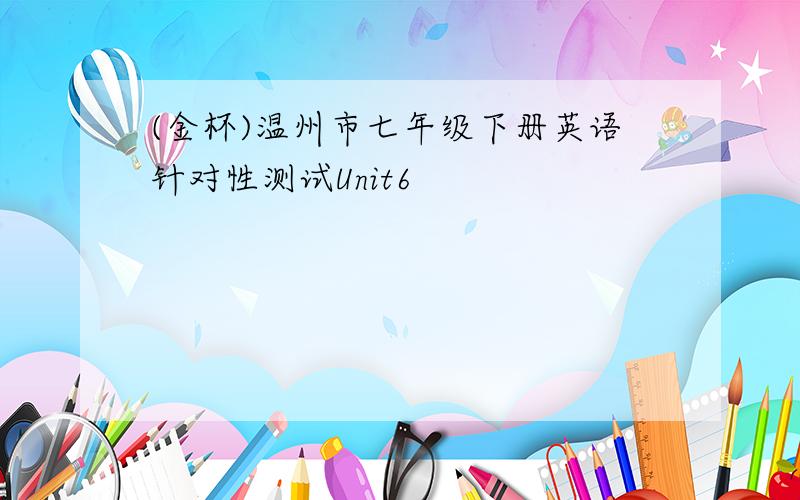(金杯)温州市七年级下册英语针对性测试Unit6
来源:学生作业帮助网 编辑:作业帮 时间:2024/11/05 22:08:13

(金杯)温州市七年级下册英语针对性测试Unit6
(金杯)温州市七年级下册英语针对性测试Unit6
(金杯)温州市七年级下册英语针对性测试Unit6
Unit 6
Topic 1
★ 重难点词汇
1.___ num.adj.第二的 n.秒
2.floor n.___
3.bedroom n.___(归纳其他房间类型)
4.upstairs adv.___
5.garden n___
6.___n.房子,住宅
7.behind prep.___(归纳其他方位介词)
8.thing n.___
9.___adj.美的,美丽的,美观的
10.large asj.___
11.left n.___(反义词是___)
12.people n.___
13.___n.镜子(归纳其他家具类词汇)
★重点短语
1. next to___
2.come in___
3.in front of___
4.talk about___
5.put away___
6.in the center of___
★重点句型
1.There is a lamp,a computer,some books and so on.
2 There isn’t a computer on the desk.
3.There aren’t any trees.
4.Is there a computer in your study?
Yes,there is.∕No,there isn′t.
5.Are there any shoes under the bed?
Yes,there are.∕No,there aren′t
6.What’s on the desk?
There are some model planes on it.
7.How many planes are there?
There are three.
8.How much water are there?
Only a little.
★日常交际用语
1.Don’t put it/them here.
2.Put it/them away,please.
3.You must look after your things.
4.I love playing on the computer in the study.
★语法
1.There be句型
▲ 定义:There be句型表示某处存在某物或某人.
▲ 结构:(1) There is +单数可数名词/不可数名词+ 地点状语.
(2) There are +复数名词+地点状语.
there是引导词,在句中不充当任何成分,翻译时也不必译出.句子的主语是某人或某物,谓语动词be要与主语(某人或某物)的数保持一致.当主语是两个或两个以上的名词时,谓语动词要与跟它最近的那个名词一致.
eg.① There is a bird in the tree.树上有一只鸟.
② There is a teacher and many students in our classroom.我们教室里有一位老师和许多学生.
③ There are two boys and a girl under the tree.树下有两个男孩,一个女孩.
▲.There be句型与have的区别:
(1) There be 句型和have都表示“有”的含义.区别如下:There be表示“某处存在某物或某人”;have表示“某人拥有某物/某人”,它表示所有、拥有关系.eg.
①He has two sons.他有两个儿子.
②There are two men in the office.办公室里有两个男人.
(2)当have表示“包括”、“存在”的含义时,There be 句型与其可互换.
eg.A week has seven days.=There are seven days in a week.一个星期有七天.
变脸一:否定句
There be句型的否定式的构成和含有be动词的其它句型一样,在be后加上not即可.例如:
There are some pictures on the wall.→There aren't any pictures on the wall.
There is a bike behind the tree.→ There isn't a bike behind the tree.
变脸二:一般疑问句
There be句型的一般疑问句变化是把be动词调整到句首,再在句尾加上问号即可,此为\"调整法\".但同时要注意:当肯定句中有some时,要将其改为any(否定变化也一样).看看下面两句是如何\"改头换面\"的吧:
There is some water on Mars.→ Is there any water on Mars?
There are some fish in the water.→Are there any fish in the water?
变脸三:特殊疑问句
There be句型的特殊疑问句形式有以下三种变化:
① 对主语提问:当主语是人时,用\"Who\'s+介词短语?\";当主语是物时,用\"What\'s + 介词短语?\".注意:无论原句的主语是单数还是复数,对之提问时一般都用be的单数形式(回答时却要根据实际情况来决定).如:
There are many things over there.→What's over there?
There is a little girl in the room.→Who is in the room?
② 对地点状语提问:提问地点当然用"Where is / are+主语?\"啦!例如:
There is a computer on the desk.→ Where is the computer?
There are four children on the playground.→Where are the four children?
③ 对数量提问:一般有两种句型结构:
How many+复数名词+are there+介词短语?
How much+不可数名词+is there+介词短语?
2.表示方位的介词或副词或介词短语:
on,in,
in front of,behind,
near,next to,
under,in the center of,
at the back of,on the left/right
between…and… close to,
from,along,
across,on the corner of…
across from